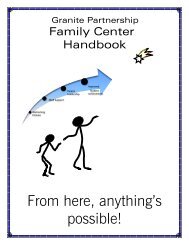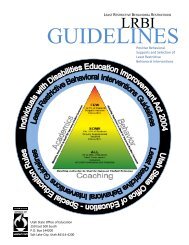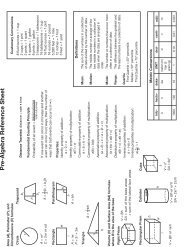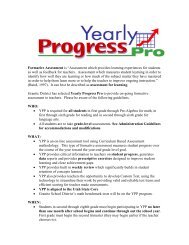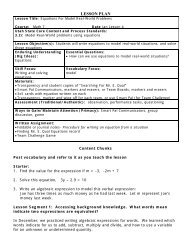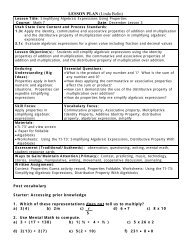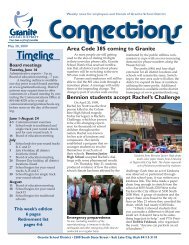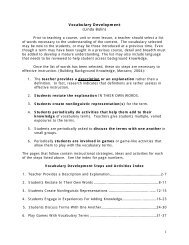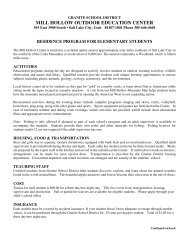LESSON PLAN (Linda Bolin) - Granite School District
LESSON PLAN (Linda Bolin) - Granite School District
LESSON PLAN (Linda Bolin) - Granite School District
Create successful ePaper yourself
Turn your PDF publications into a flip-book with our unique Google optimized e-Paper software.
<strong>LESSON</strong> <strong>PLAN</strong> (<strong>Linda</strong> <strong>Bolin</strong>)<br />
Lesson Title: Representing Patterns and Evaluating Expressions<br />
Course: Pre-Algebra Date: November Lesson 1<br />
Utah State Core Content and Process Standards:<br />
3.1c Create and extend simple numeric and visual patterns<br />
a) 3.1b Describe patterns using mathematical rules and algebraic expressions<br />
3.2a Evaluate algebraic expressions, including those with whole number exponents, when<br />
given values for the variables<br />
Lesson Objective(s): Students will create and extend patterns, write algebraic expressions<br />
to model rules or patterns, and evaluate algebraic expressions for a given value.<br />
Enduring Understanding (Big<br />
Ideas):<br />
Patterns and sequences<br />
Algebraic representation<br />
Skill Focus:<br />
Create and extend patterns.<br />
Write and evaluate algebraic<br />
expressions to model patterns.<br />
Essential Questions:<br />
• What real-world patterns can be modeled by a sequence<br />
of terms? How can I use a rule to find more terms in a<br />
sequence?<br />
• How can an algebraic expression be used to model the<br />
rule for a pattern?<br />
• When do we use substitution in the real-world?<br />
• Given a value for the variable, what is the value for the<br />
algebraic expression?<br />
• How does changing the value of the variable affect the<br />
value of an expression?<br />
Vocabulary Focus:<br />
Fibonacci numbers, triangular numbers, variable, algebraic<br />
expression, substitution, evaluate<br />
Materials:<br />
• “Writing the Rule” cards for students, TI-73’s<br />
• Color Tiles<br />
• Pattern Blocks Smart Pals<br />
• Stand Up Card packet for each team<br />
• One deck of cards<br />
• Worksheets: Patterns In Our World, Building A Square Patio Patterns, Polygon Trains<br />
• Journal page: Defining Algebraic Expression<br />
• Game worksheets (Optional Practice) : Evaluating Expressions Tic Tac Toe, Evaluating<br />
Expressions War<br />
Assessment (Traditional/Authentic): observation, questions, task performance<br />
Ways to Gain/Maintain Attention (Primacy): manipulatives, game, patterns, technology,<br />
cooperative activities, connections to real world<br />
Written Assignment:<br />
• Patterns In Our World<br />
• Writing the rule game (Can be written on the back of the Patterns worksheet)<br />
• Building A Square Patio Patterns<br />
• Pattern Block: Polygon Train<br />
• Team Challenge<br />
• McDougal Littell p.695/3-8; p696/29, 30a or other appropriate practice.<br />
List the vocabulary on the board<br />
Starter: simplify each<br />
Content Chunks<br />
1. -2[3 • (5² – 15)] 2. -0.25 ÷ 0.5 + 1.5 3. ¾ + (- ½ )
Lesson Segment 1: What real-world patterns can be modeled by a sequence<br />
of terms? How can an algebraic rule be used to find more terms for the<br />
sequence?<br />
Patterns are all around us. Finding patterns and sequences helps pharmacists<br />
develop medicines, builders build structures, farmers plant crops, and even helps you<br />
know when to go to classes. (every 90 min a bell rings).<br />
Do Team List where a Round Robin is used to have team members suggest<br />
anywhere they might see a pattern in the world. Scribe writes list. Team with longest<br />
after 2 minutes wins. Have that team scribe read their list. Scribes from other teams<br />
each read one idea that hasn’t been mentioned yet.<br />
Introduce the Patterns In Our World Worksheet. Do Four Corners where a student<br />
from each team goes to a corner to meet with other team’s students to complete the<br />
pattern or sequence shown in one of the problems on worksheet (attached) and to<br />
write a rule for the pattern they found to help them. Each person then returns to their<br />
team and teaches the team about their one problem, so all four problems get<br />
discussed. Students are all accountable to write the next two terms and the<br />
description of the pattern on their own worksheet.<br />
TI-73 activity: All patterns can be modeled using verbal or written rules, and by using<br />
math symbols. That is why mathematics is such a powerful language.<br />
Q. Think-Team-Share For example, in this pattern: 1, 2, 3, 4, 5, 6…, what operation is<br />
happening to one number to get the next term in the sequence?<br />
We can write the rule for finding the next term using math symbols. So if n was a<br />
number in the pattern, n + 1 would be the rule to help us find the next number.<br />
Q. What would the next number be if the number you were looking at were 52? 65?<br />
Demonstrate using the graphing calculator to find terms of a sequence and write the<br />
rule (algebraic expression) for finding the next term. Then play “Writing The Rule”.<br />
Instructions are attached.<br />
Lesson segment 2: How can algebraic expressions be used to model a rules or<br />
patterns? Given a value for a variable, what is the value for the expression?<br />
Have students look at these two columns and identify characteristics that would qualify<br />
an expression for being in one column or the other. The expressions on the left are<br />
algebraic since they include at least one variable. The expressions on the right are<br />
numeric since they only include numbers and operations having no variable.<br />
y + 1 3 + 5.8<br />
r*t 12 • (-4)<br />
lwh 2 • 3 • 6<br />
2(3x -2) 2(6 – 2)<br />
Algebraic or variable expressions can help us describe patterns and extend them to find<br />
other possible values.<br />
Journal: Work with students to complete the Frayer Model for defining Algebraic<br />
Expression (attached)
Manipulative Patterns<br />
Color Tiles: Have student pairs work with Color Tiles to complete the first five rows in<br />
the “Building A Square Patio Patterns” table. The activity is a review of the<br />
manipulative activity found in the exponential lesson with additional patterns included.<br />
Discuss the patterns they find. Ask them to look for a rule that would involve<br />
operations on the length of the side of a square to find the information for the table.<br />
Use the “X” row to write algebraic expressions modeling the rule for the patterns.<br />
(# added on = 2x-1. Perimeter = 4x, Area = x², Radical expression = √x² = x)<br />
Pattern Blocks, Smart Pals: Use the attached Pattern Blocks: Polygon Trains<br />
worksheet for discussion, Having the students work with a partner. Students should<br />
take turns building the trains and sketching and labeling on the Smart Pal. Guide them<br />
in recording the data in the tables on the worksheet and discuss the pattern for each<br />
train. Again, ask them to look for a rule to help them find the number of windows by<br />
operating on the number of cars in the train. Let x represent the number of cars in the<br />
train.<br />
Writing Expressions from Tables Using The TI-73<br />
To find patterns leading to the writing of single variable expressions, type an<br />
equation in the &. Select -'and set the dependent and independent variables<br />
to Aask@. Select -*and push bto type a value in the X column. Tell students<br />
you have performed an operation on that value to get a result. Place the curser in the<br />
Y column and push b. Discuss what operation(s) might have been performed to<br />
get that result. Type another value in the X column and push b in the<br />
corresponding position in the Y column. Ask students if the same operation they<br />
discussed was used on this new value for x to get the resulting value in the Y column.<br />
If not, tell them you want them to find an operation(s) that could be used for both x<br />
values to get the result in the table. Have them describe a “rule”. Then, type a third<br />
value in the X column. Ask them if their rule works for that value. Then enter the<br />
corresponding value in the Y column and see if they got the same result.<br />
Enter two or three more values in the x column. Have them write an expression<br />
that would produce the given value for each x value. For example if the “rule” were to<br />
add 5 to X to get a result the expression would be 5 + X . Some possible functions you<br />
may wish to try might be:<br />
y = x + 1, y = 2x, y = x – 4, y = 2 x, y = 2x + 1, y = x/2<br />
Lesson segment 3: When do we use substitution in life? Given a value for a<br />
variable, what is the value for the expression? How does changing the value<br />
for the variable affect the value of the expression?<br />
Have you ever been in a class where you were surprised when you came in to find a<br />
substitute teacher was there?<br />
Think-Team-Share Q: What do we mean when we say the word “substitute”?<br />
Think-Team-Share Q: Where do we see substituting things going on in the real<br />
world? (Splenda for sugar, Pinch-hit at a ball game)
Have you ever been in a class where the teacher was gone more than one day, and<br />
you had a different substitute each day?<br />
Think-Team-Share Q: How did changing a substitute change the class?<br />
In mathematics we can substitute too. In an algebraic expression, we can<br />
substitute values for the variable.<br />
Have you ever gone to the store and tried to decide how many of something you<br />
could buy? For example, if a candy bar is 25 cents, you know you will have to pay<br />
$0. 25 x the number of candy bars (write 0.25c on the board).<br />
Let’s do some mental math. How much would you have to pay if you bought 2 candy<br />
bars? 3 candy bars? 6 candy bars? You have been doing mental substitution. First,<br />
you replaced the c with a 2 to get $0.50. (Write $0.25(2) = $0.50 on the board) Then<br />
you substituted a 3 for the c and got $0.75. (Write $0.25(3) = $0.75). Finally, you<br />
substituted a 6 for the c and got $1.50. (Write $0.25(6) = $1.50 on the board).<br />
Have students write the expression $0.25c on their paper and choose any<br />
number of candy bars and evaluate their expression. Then select several students to<br />
tell what value they chose for c and tell the class the cost of the candy bars.<br />
Think-Team-Share Q: How did changing the value of c change the amount you had to<br />
pay?<br />
Team Challenge Game: (materials: Stand-Up cards, one card deck, TI-73’s)<br />
Give each team a pack of Stand-Up Cards (Large cards numbered from 1-20,<br />
operation signs cards, right and left parenthesis cards, a couple of variable cards, and a<br />
negative sign card. Have each team use the cards to create an algebraic expression<br />
(not an equation). The challenger team stands holding their cards to show the<br />
expression they have created. The class and teacher write the expression. The<br />
challenger team then asks a classmate to come to the front of the class and pick a<br />
card(s) from a playing card deck the teacher is holding. The picker selects a card for<br />
each variable in the challenger team’s expression. Red cards in the deck represent<br />
negative numbers. Black cards represent positive numbers.<br />
All the students then work to evaluate the expression using the drawn card(s) as<br />
value(s). The challengers then pick one student to show explain how they evaluated<br />
the expression. If that student is correct, his/her team gets a point. If not, the<br />
challengers must show how to evaluate the expression correctly to earn the point.<br />
Remind students to use the correct order of operations. Model this procedure<br />
once with the class.<br />
Assign: Practice Writing and Evaluating Expressions Using The Ti-73. For additional<br />
practice assign Writing Expressions Tic Tac Toe, and Writing Expressions War (all<br />
attached). McDougal Littell 2005 p. 7, # 1-31 odd. or any appropriate text practice for<br />
evaluating expressions<br />
Rules for the practice problems on the Writing and Evaluating Expressions Practice<br />
page are<br />
1. 2x + 1<br />
2. x – 2.5<br />
3. x + 4<br />
4. – 1 x
Name__________________<br />
Patterns can be found all around you. Sketch the next two pictures for the patterns<br />
shown below, and then describe the pattern that helped you know what to sketch.<br />
1. A pattern that often occurs in building is called a triangular pattern. Here’s what<br />
this pattern looks like:<br />
9 9 9 9 9<br />
999 999 999 999<br />
99999 99999 99999<br />
9999999 9999999<br />
999999999<br />
2. Some Native American designs include square patterns that look like this<br />
• • • •<br />
• • • •<br />
• • • •<br />
• • • •<br />
3. The number of petals on a pinecone or sections around a pineapple increase in a<br />
sequence known as a Fibonacci Sequence named for the mathematician who<br />
discovered it. If the sections were unwound and laid in rows, they would look like this:<br />
− −− −−− −−−−− −−−−−−−−<br />
4. A game where a ball moves through a maze to an end point can have several paths<br />
the ball could follow to get there. The number of paths can often be modeled by<br />
another famous sequence known as Pascal’s Sequence named for the mathematician<br />
who discovered it.<br />
1<br />
1 1<br />
1 2 1<br />
1 3 3 1<br />
1 4 6 4 1<br />
1 5 10 10 5 1<br />
5. On the back of this paper, sketch a pattern of your own. Explain how you know<br />
what each step of the pattern will be.
Writing The Rule<br />
Hand several students a card. See examples below. Each card has a beginning<br />
number and a rule written on the card. The person getting the card starts with the<br />
beginning number and applies the rule to generate three more numbers in the<br />
sequence. That person then tells the class the beginning number and the next three<br />
numbers in the sequence. Class members are given time to guess a rule by writing<br />
that rule on their calculator and on their paper. The person with the card then reads<br />
the next number in the sequence and gives the class time to change or refine the rule<br />
they had originally written. This process continues until someone in the class is ready<br />
to guess the rule. The guesser using the teacher=s overhead screen types the rule and<br />
shows the sequence. Then next person with a card then challenges the class in the<br />
same manner.<br />
Calculator steps: Press original number, then press X I b. Next, type the<br />
rule algebraically (ex. x + 3 ). Then press X I b. Continue pushing b to<br />
generate more terms of the sequence.<br />
Begin with: 1.5<br />
Begin with: 10<br />
Begin with: ½<br />
Rule: add 2 to each<br />
term<br />
Rule: add - 2 to<br />
each term<br />
Rule: Multiply each<br />
term by 3<br />
Begin with: 24<br />
Begin with: 2<br />
Begin with: 3<br />
Rule: Multiply each<br />
term by ¼<br />
Rule: square each<br />
term<br />
Rule: Multiply each<br />
number by 3<br />
Begin with: 1.12<br />
Begin with: 4<br />
Begin with: 6.45<br />
Rule: Add 0.03 to<br />
each term<br />
Rule: subtract 0.25<br />
from each term<br />
Rule: subtract 0.15<br />
from each term
Defining ______________<br />
Name ____________________________<br />
Date________<br />
1. Sketch, drawing or connection 2. Facts about the<br />
(this reminds me of…)<br />
word<br />
Algebraic<br />
3a. Two examples<br />
Expression<br />
4. Definition in your<br />
own words<br />
3b. Two non-examples
Building A Square Patio Patterns<br />
Name_________________<br />
Date ________<br />
As you build a model for a patio using square tiles, you notice some<br />
patterns that help you predict. Write expressions to find each. Work with<br />
your team to build each model in the table. Look for a rule that includes<br />
operating on the length of a side of the patio.<br />
Sketch the Length of # of tiles Perimeter Area Radical<br />
patio one side added to expression<br />
last patio<br />
1" 1 4 1² √1² = 1<br />
2" 3 8 2² √2² = 2<br />
3"<br />
4”<br />
5"<br />
X”<br />
1. What would the area be if x = 8? 5½ ?<br />
2. What would the perimeter if x = 50? 10.2?<br />
3. What would the number added on be when x = 32? 3.5?<br />
4. What would x be if the area were 400? 0.25?
Pattern Blocks: Polygon Trains<br />
Name____________________<br />
You are the designer of a unique train ride attraction using<br />
polygon shaped cars. Each exposed side of a polygon will need<br />
to have a window for a passenger. Complete a table. Beside<br />
each table, write an algebraic expression for finding the number<br />
of windows if X represents the number of cars. Then find the<br />
number of windows if there are 20 cars, 50 cars, 100 cars.<br />
1) This train will have triangular cars<br />
Cars in the<br />
train (X)<br />
Total<br />
windows<br />
1 3<br />
2 4<br />
3 5<br />
4<br />
x<br />
2) This train will have square cars<br />
Cars in the<br />
train (X)<br />
Total<br />
windows<br />
1 4<br />
2 6<br />
3<br />
4<br />
x<br />
3) This train will have trapezoidal<br />
cars<br />
4) This train will have rhombus<br />
cars<br />
Cars in the<br />
train (X)<br />
Total<br />
windows<br />
Cars in the<br />
train (X)<br />
Total<br />
windows<br />
5) This train will have hexagonal<br />
cars<br />
6) This train will have octagonal<br />
cars<br />
Cars in the<br />
train (X)<br />
Total<br />
windows<br />
Cars in the<br />
train (X)<br />
Total<br />
windows
Practice Writing and Evaluating<br />
Expressions from Tables<br />
Name _________________<br />
Date ________<br />
For each of the tables below<br />
a) Explain in words what operations you see must be performed on the<br />
x variable to get the result in the Y column.<br />
b) Write an expression to the right of the = sign below the table to<br />
show the operation(s)<br />
c) Use the expression to fill in the missing values in the Y column.<br />
Show your justification.<br />
1. 2.<br />
3. 4.
Name__________________________ Date______<br />
Evaluating Expressions Tic Tac Toe<br />
First: Arrange these numbers in any order in the little boxes in each square. Use only<br />
one number per square please. 0, 1, 3, 4, 5, 8, 10, 20, 48<br />
Next: Evaluate each expression below. Show how you substituted the value given.<br />
Write each expression in the square above where you have placed its value.<br />
3b², when b = 1 3b², when b = - 4 3b², when b = 0<br />
2m 0 + 3, if m = 6 2m + 3, if m = - 1 2m + 3, if m = ½<br />
2(5 – X), if X = 0 2(5 – X), if X = 1 2(5 – X), if X = - 5<br />
Teacher will now draw values from a box. When you get three in a row, say “I have<br />
Tic, Tac, Toe”
Evaluating Expressions War<br />
Name ____________________<br />
Date________<br />
Players: 2<br />
Materials: One deck of cards (Black cards represent positive numbers; red are<br />
negative.), worksheet for each player.<br />
Procedure: Both players draw 1 card for each variable. Substituting the card(s)<br />
drawn, each player evaluates their expression . The player whose<br />
expression has the greatest value wins all cards for that expression. The<br />
player with the most cards wins the game. If a tie occurs, leave the<br />
cards. The winner of the next round gets all these cards, too.<br />
1. -3m² + 4 2. ½ w – 4<br />
3. r + r – p 4. _Y_ + (-2)<br />
2<br />
5. -3 – d 6. b + 3c – a³<br />
4<br />
7. _x + y_ 8. -8k ÷ jk<br />
w – z




